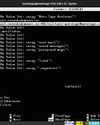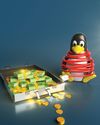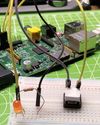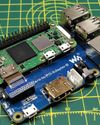Pinhole photography with the HQ Camera
Linux Format
|October 2021
Interchangeable lenses enable us to experiment with that historical curiosity, the pinhole camera, Mike Bedford shows you how.

The pinhole camera might date back to 1856, but it would be wrong to think it predated cameras with lenses. Instead, it seems that the idea of a lens-less camera was always intended as a curiosity, not a serious suggestion for a practical camera. It has been used as such by enthusiasts, but in the main pinhole cameras have been employed as teaching aids. Irrespective of whether you want to learn more about optics and photography by experiment, or take some shots with a rather unique look, if you have a healthy curiosity we’re confident that you’ll enjoy trying our various hands-on exercises.
A pinhole camera can be nothing more complicated than a cardboard box, as we demonstrate with our first experiment. While it might seem incongruous to mix old and new technology in this way, we then bring the concept up to date by showing you how to use a Raspberry Pi HQ Camera as a pinhole camera. This isn’t just a desktop exercise though – we also provide some guidance on how to make that pinhole camera portable so you can use in the great outdoors.
Because pinhole photos aren’t always perfect as they come out of the camera, we’ll offer some brief thoughts on photo processing. Finally, to round off our look at this primitive form of photography, we also take a look at pinhole photography with a DSLR.
Illuminating in a cardboard box
Right at the start we have to come clean and admit that you’re probably not going to take a photo with our first pinhole camera, even though it’s quite feasible to do so. Instead, the real purpose of this experiment is to demonstrate how simple a pinhole camera can be – after all, this one is just a cardboard box – and to give you a better feel for what’s happening when we get embroiled in high-tech pinhole cameras.
このストーリーは、Linux Format の October 2021 版からのものです。
Magzter GOLD を購読すると、厳選された何千ものプレミアム記事や、10,000 以上の雑誌や新聞にアクセスできます。
すでに購読者ですか? サインイン
Linux Format からのその他のストーリー

Linux Format
Create your first WebSocket service
Mihalis Tsoukalos explains how to use the Go programming language to work with the WebSocket protocol.
9 mins
April 2023

Linux Format
Fantastic Mr Firefox
Nick Peers takes a trip down memory lane to reveal the story behind the rise - and slight fall - of Mozilla's popular web browser.
9 mins
April 2023

Linux Format
Set up your terminal and email like it's 1983
Jump in the hot terminal time machine with Mats Tage Axelsson who emails from the command line using the latest technology.
8 mins
April 2023

Linux Format
Universal layer text effects with GIMP
Posters use them, films and presentations are hard to imagine without them: text effects. Attract attention with Karsten Günther and GIMP.
8 mins
April 2023

Linux Format
Jump to a federated social network
Nick Peers reveals how you can get up and running with this free, decentralised and non-profit alternative to Twitter.
9 mins
April 2023

Linux Format
Free our SOFTWARE!
Taking anything for granted is dangerous, so Jonni Bidwell and Mike Saunders revisit how the free software movement got started to help free us from proprietary tyranny!
4 mins
April 2023

Linux Format
Master RPI.GPIO
Les Pounder goes back to the early days of the Raspberry Pi - and his career with this classic library! -
5 mins
April 2023

Linux Format
Waveshare Zero to Pi3
Transform your Pi Zero into a Pi 3, they promised Les Pounder, but it's more like adding on go-faster stripes.
2 mins
April 2023

Linux Format
The Best OPEN SOURCE Software Ever!
In an attempt to trigger controversy, Michael Reed and Neil Mohr unequivocally state these are the greatest free software apps ever. Probably. We’re just trying to be helpful.
19 mins
April 2023

Linux Format
Linux-Mandrake 7
Simplicity and a wide range of applications make this a great distribution for all Linux users.
2 mins
April 2023
Translate
Change font size

